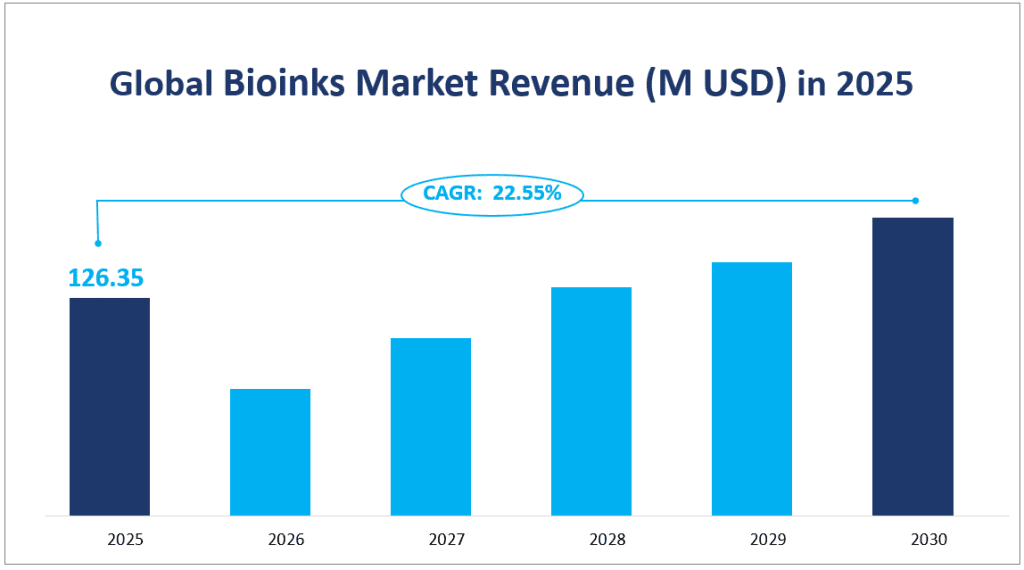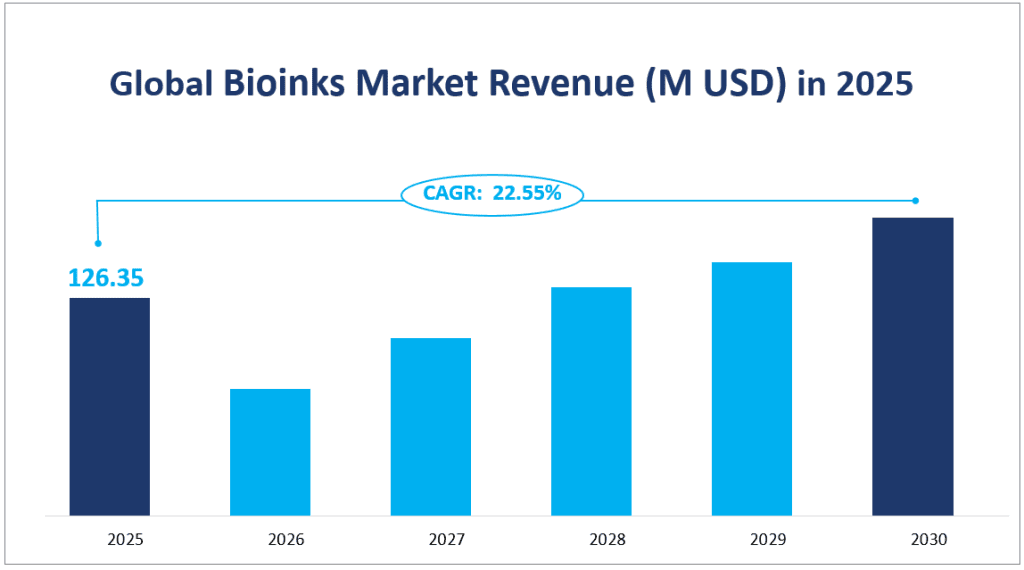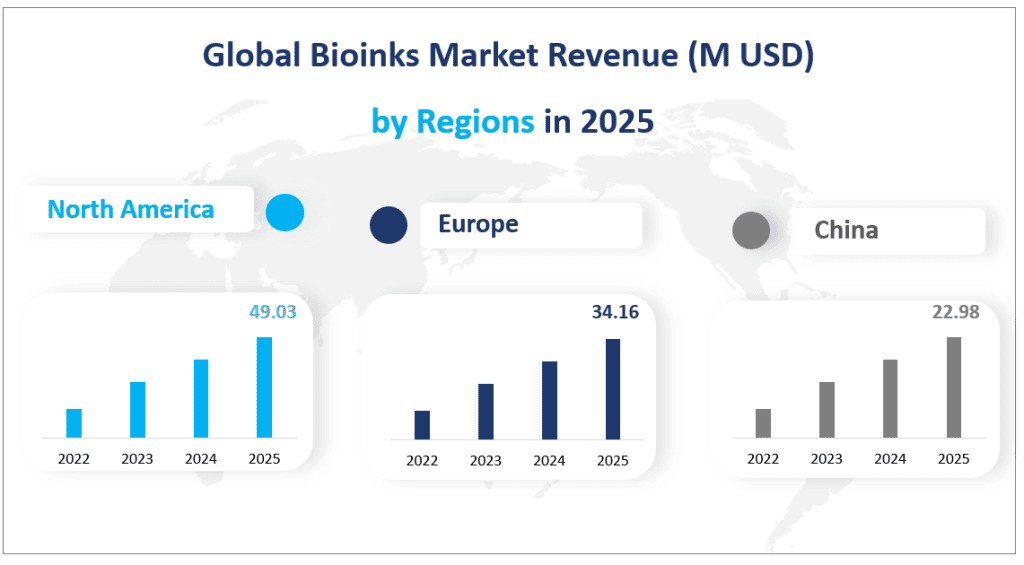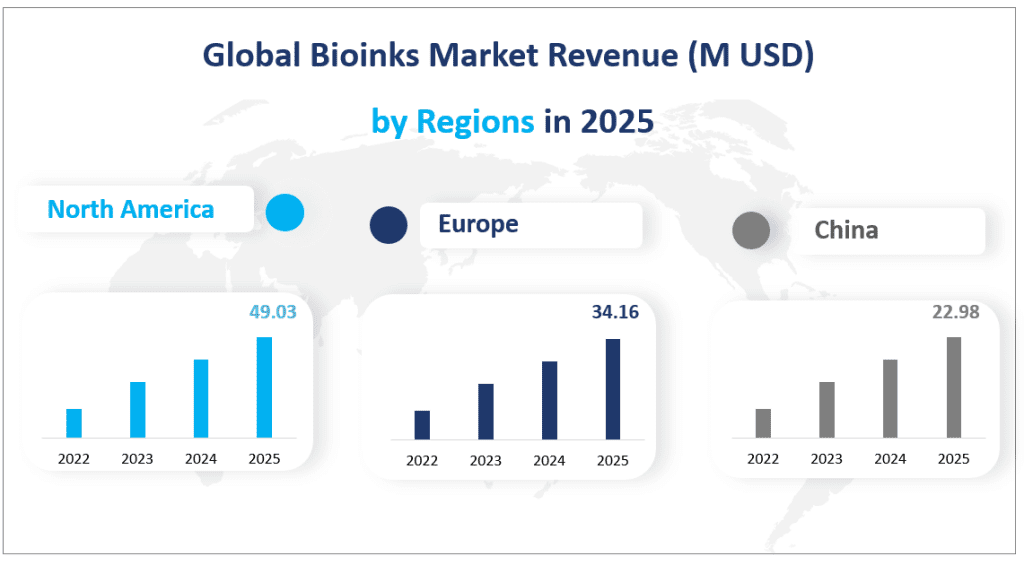1. Global Bioinks Market Definition
By 2025, the global bioinks market size is projected to reach $126.35 million with a CAGR of 22.55% from 2025 to 2030.
Bioinks are specialized materials used in 3D bioprinting to create engineered or artificial living tissues. These inks are primarily composed of cells, often combined with biopolymer gels to form a printable material that mimics the natural extracellular matrix of living tissues. The composition of bioinks must meet several critical characteristics, including rheological properties (flow behavior), mechanical stability, biofunctionality, and biocompatibility. These properties ensure that the printed constructs are not only structurally sound but also conducive to cell growth and tissue development.
Global Bioinks Market Revenue (M USD) in 2025


2. Driving Factors of Bioinks Market
The growth of the global bioinks market is driven by several key factors. The increasing demand for tissue engineering and regenerative medicine is a primary driver, as these fields rely heavily on bioinks to create functional tissues and organs. Advances in 3D bioprinting technology have also expanded the capabilities of bioinks, enabling more complex and precise tissue constructs. Additionally, the growing need for personalized medicine and the development of advanced drug delivery systems further fuel the market’s expansion.
Technological innovation is another significant driver of market growth. Companies are continuously investing in research and development to create bioinks with enhanced properties, such as improved printability, biocompatibility, and mechanical stability. For example, CELLINK’s bioinks are composed of non-animal-derived polysaccharides, offering superior performance for 3D bioprinting applications. Similarly, UPM Biomedicals’ GrowInk™ bioinks provide a fully defined matrix that can be customized for specific cellular requirements.
3. Limiting Factors of Bioinks Market Growth
However, the bioinks market also faces several limiting factors. One of the primary challenges is the technical difficulty in developing bioinks that balance printability and biocompatibility. Materials that are ideal for 3D printing often have properties that negatively affect cellular growth and tissue development. Additionally, the regulatory environment for bioinks is stringent, with the US FDA approving only a few hydrogels for clinical applications. This regulatory complexity can slow down the adoption of new bioinks in medical settings.
Another limiting factor is the high technical barrier to entry for new companies. The production of bioinks requires advanced technological capabilities, significant investment in research and development, and expertise in materials science and biotechnology. Established companies in the market have a competitive advantage due to their existing technological infrastructure and brand recognition, making it difficult for new entrants to gain a foothold.
4. Analysis of Bioinks Product Types: Market Size and Growth Dynamics in 2025
These bioinks are designed for cell encapsulation and provide a supportive environment for living cells. They are primarily composed of natural hydrogels such as collagen, hyaluronic acid, or alginate. By 2025, the market size for Matrix Bioinks is projected to reach $60.94 million, representing the largest market share among the three types. This dominant position is attributed to their versatility and essential role in various tissue engineering applications.
These materials are used to create channels or empty regions within printed structures, facilitating cellular migration and nutrient transportation. They are typically designed to be removed after printing to create functional voids. In 2025, the market size for Sacrificial Bioinks is expected to be $34.13 million. Although they hold a smaller market share compared to Matrix Bioinks, their importance in creating complex vascular networks cannot be overstated.
These bioinks act as artificial extracellular matrices, providing structural support during the early stages of tissue development. They are crucial for maintaining the integrity of printed constructs, especially those with intricate designs. The market size for Support Bioinks in 2025 is projected to be $31.27 million. Similar to Sacrificial Bioinks, they play a vital role in ensuring the stability of bioprinted tissues.
Matrix Bioinks is expected to maintain the largest market share in 2025, accounting for approximately 48.23% of the total bioinks market. Their dominance is attributed to their essential role in creating functional tissues and organs, as well as their compatibility with various bioprinting technologies.
Market Applications
Tissue Engineering application involves the creation of functional tissues and organs for medical use. By 2025, the market size for Tissue Engineering is projected to reach $47.62 million, representing the largest market share among the applications. This dominant position is attributed to the increasing demand for organ replacement and tissue regeneration, driven by advancements in regenerative medicine.
Drug Delivery application focuses on developing targeted drug delivery systems using bioinks. By 2025, the market size for Drug Delivery is expected to be $31.88 million. Although smaller than Tissue Engineering, this segment is growing rapidly due to the need for more efficient and personalized drug therapies.
Medical Diagnostics and Biosensors application involves the development of biosensors and diagnostic tools using bioinks. By 2025, the market size for Medical Diagnostics and Biosensors is projected to be $22.96 million. Their importance in medical diagnostics and research is driving steady growth in this segment.
Structural Genomics application involves the study of protein structures and their role in biological processes. By 2025, the market size for Structural Genomics is expected to be $14.76 million. This segment is growing due to advancements in structural biology and the need for detailed protein structure analysis.
In summary, Tissue Engineering is poised to hold the largest market share and exhibit the fastest growth rate among the different applications of bioinks. Its importance in regenerative medicine and the increasing demand for tissue and organ replacement makes it a key driver of the bioinks market. Drug Delivery, Medical Diagnostics and Biosensors, and Structural Genomics, while smaller in market size, remain crucial for advancing medical research and personalized medicine.
Market Size by Segment
| Market Size (M USD) in 2025 | ||
| By Type | Matrix Bioinks | 60.94 |
| Sacrificial Bioinks | 34.13 | |
| Support Bioinks | 31.27 | |
| By Application | Tissue Engineering | 47.62 |
| Drug Delivery | 31.88 | |
| Medical Diagnostics and Biosensors | 22.96 | |
| Structural Genomics | 14.76 |
5. Regional Bioinks Market
North America is projected to remain the largest regional market for bioinks in 2025, with a market size of $49.03 million. The region’s dominance is attributed to its advanced healthcare infrastructure, significant investment in research and development, and the presence of leading biotechnology companies.
Europe is another major player in the bioinks market, with a projected market size of $34.16 million in 2025. The region’s strength lies in its robust scientific research ecosystem, regulatory support for biotechnology, and a high demand for advanced medical solutions.
China is emerging as a significant market for bioinks, driven by rapid economic growth, increasing investment in healthcare, and a focus on innovation in biotechnology. By 2025, China’s bioinks market is projected to reach $22.98 million.
While North America is the largest market by production, the fastest-growing region is expected to be China. China’s market is projected to grow at a significant rate, driven by rapid economic development, increased investment in healthcare, and a focus on innovation in biotechnology. The country’s commitment to advancing medical research and the adoption of advanced bioprinting technologies are key factors contributing to its rapid growth.
Global Bioinks Market Revenue (M USD) by Regions in 2025


6. Analysis of the Top 3 Companies in the Bioinks Market
Company Introduction and Business Overview:
UPM Biomedicals is a leading company in the development and supply of innovative, sustainable wood-based biomedical products. Established in 1996, the company is headquartered in Finland and operates globally. UPM Biomedicals focuses on providing high-quality bioinks derived from renewable wood sources, which are ideal for 3D bioprinting applications.
Products Offered:
UPM Biomedicals offers a range of bioinks, including GrowInk™, which is animal-free and biocompatible. These bioinks are designed to mimic the in vivo environment, supporting cell growth and differentiation. The company also provides customized solutions for specific cellular requirements.
Company Introduction and Business Overview:
CELLINK is a Swedish biotech company known for commercializing the first universal bioink for 3D bioprinting. Established in 2016, CELLINK has quickly become a global leader in the field. The company’s bioinks are widely used in tissue engineering, cancer research, disease models, and drug testing.
Products Offered:
CELLINK offers a variety of bioinks, including CELLINK Bioink, which is composed of non-animal derived polysaccharides. These bioinks are compatible with various 3D bioprinting systems and offer superior printability and biocompatibility. The company also provides specialized bioinks for different applications, such as cancer research and tissue engineering.
Company Introduction and Business Overview:
StemEasy is a Chinese company specializing in the development and application of stem cells and 3D bioprinting technology. Established in 2007, StemEasy provides stem cell products and 3D bioprinting services to research institutions and hospitals worldwide.
Products Offered:
StemEasy offers a range of bioinks, including Type I Collagen Methacrylamide (Col 1 MA), which is photosensitive and can be used for 3D printing applications. The company’s bioinks are designed to support cell adhesion and proliferation, making them suitable for various tissue engineering applications.
Major Players
| Company Name | Headquarter | Sales Region |
| UPM Biomedicals | Finland | Worldwide |
| CELLINK | Sweden | Worldwide |
| StemEasy | China | Mainly in Asia, North America, Europe |
| CollPlant | Israel | Worldwide |
| Brinter | Finland | Worldwide |
| SunP Biotech | USA | Mainly in North America, Europe, and APAC |
| Allevi | USA | Worldwide |
| Manchester BIOGEL | UK | Mainly in Europe |
1 Report Overview
1.1 Study Scope
1.2 Key Market Segments
1.3 Players Covered: Ranking by Bioinks Revenue
1.4 Market Analysis by Type
1.4.1 Global Bioinks Market Size Growth Rate by Type: 2021 VS 2028
1.4.2 Matrix Bioinks
1.4.3 Sacrificial Bioinks
1.4.4 Support Bioinks
1.5 Market by Application
1.5.1 Global Bioinks Market Share by Application: 2021 VS 2028
1.5.2 Tissue Engineering
1.5.3 Drug Delivery
1.5.4 Medical Diagnostics and Biosensors
1.5.5 Structural Genomics
1.6 Study Objectives
1.7 Years Considered
2 Global Growth Trends
2.1 Global Bioinks Market Perspective (2017-2028)
2.2 Bioinks Growth Trends by Region
2.2.1 Bioinks Market Size by Regions: 2017 VS 2022 VS 2028
2.2.2 Bioinks Historic Market Share by Regions (2017-2022)
2.2.3 Bioinks Forecasted Market Size by Regions (2022-2028)
2.3 Industry Trends and Growth Strategy
2.3.1 Market Top Trends
2.3.2 Market Drivers
2.3.3 Market Challenges
2.3.4 Porter’s Five Forces Analysis
2.3.5 Bioinks Market Growth Strategy
3 Competition Landscape by Key Players
3.1 Global Bioinks Players by Market Size
3.1.1 Global Bioinks Revenue by Players (2017-2022)
3.1.2 Global Bioinks Revenue Market Share by Players (2017-2022)
3.1.3 Global Bioinks Market Share by Company Type (Tier 1, Tier 2 and Tier 3)
3.2 Global Bioinks Market Concentration Ratio
3.2.1 Global Bioinks Market Concentration Ratio (CR5 and HHI)
3.2.2 Global Top 6 and Top 3 Companies Revenue in 2021
3.3 Bioinks Key Players Head office
3.4 Bioinks Key Players Area Served
3.5 Key Players Established Time
3.6 Mergers & Acquisitions, Expansion Plans
4 Market Size by Type (2017-2028)
4.1 Global Bioinks Historic Market Size by Type (2017-2022)
4.2 Global Bioinks Forecasted Market Size by Type (2022-2028)
5 Market Size by Application (2017-2028)
5.1 Global Bioinks Historic Market Size by Application (2017-2022)
5.2 Global Bioinks Forecasted Market Size by Application (2022-2028)
6 North America
6.1 North America Bioinks Market Size (2017-2022)
6.2 Bioinks Key Players in North America
6.3 North America Bioinks Market Size by Type
6.4 North America Bioinks Market Size by Application
7 Europe
7.1 Europe Bioinks Market Size (2017-2022)
7.2 Bioinks Key Players in Europe
7.3 Europe Bioinks Market Size by Type
7.4 Europe Bioinks Market Size by Application
8 China
8.1 China Bioinks Market Size (2017-2022)
8.2 Bioinks Key Players in China
8.3 China Bioinks Market Size by Type
8.4 China Bioinks Market Size by Application
9 Japan
9.1 Japan Bioinks Market Size (2017-2022)
9.2 Bioinks Key Players in Japan
9.3 Japan Bioinks Market Size by Type
9.4 Japan Bioinks Market Size by Application
10 Southeast Asia
10.1 Southeast Asia Bioinks Market Size (2017-2022)
10.2 Bioinks Key Players in Southeast Asia
10.3 Southeast Asia Bioinks Market Size by Type
10.4 Southeast Asia Bioinks Market Size by Application
11 India
11.1 India Bioinks Market Size (2017-2022)
11.2 Bioinks Key Players in India
11.3 India Bioinks Market Size by Type
11.4 India Bioinks Market Size by Application
12 Central & South America
12.1 Central & South America Bioinks Market Size (2017-2022)
12.2 Bioinks Key Players in Central & South America
12.3 Central & South America Bioinks Market Size by Type
12.4 Central & South America Bioinks Market Size by Application
13 Key Players Profiles
13.1 UPM Biomedicals
13.1.1 UPM Biomedicals Company Details
13.1.2 Business Overview
13.1.3 Bioinks Introduction
13.1.4 UPM Biomedicals Revenue in Bioinks Business (2017-2022)
13.1.5 UPM Biomedicals Recent Development
13.2 Cellink
13.2.1 Cellink Company Details
13.2.2 Business Overview
13.2.3 Bioinks Introduction
13.2.4 Cellink Revenue in Bioinks Business (2017-2022)
13.2.5 Cellink Recent Development
13.3 StemEasy
13.3.1 StemEasy Company Details
13.3.2 Business Overview
13.3.3 Bioinks Introduction
13.3.4 StemEasy Revenue in Bioinks Business (2017-2022)
13.4 CollPlant
13.4.1 CollPlant Company Details
13.4.2 Business Overview
13.4.3 Bioinks Introduction
13.4.4 CollPlant Revenue in Bioinks Business (2017-2022)
13.4.5 CollPlant Recent Development
13.5 Brinter
13.5.1 Brinter Company Details
13.5.2 Business Overview
13.5.3 Bioinks Introduction
13.5.4 Brinter Revenue in Bioinks Business (2017-2022)
13.6 SunP Biotech
13.6.1 SunP Biotech Company Details
13.6.2 Business Overview
13.6.3 Bioinks Introduction
13.6.4 SunP Biotech Revenue in Bioinks Business (2017-2022)
13.7 Allevi
13.7.1 Allevi Company Details
13.7.2 Business Overview
13.7.3 Bioinks Introduction
13.7.4 Allevi Revenue in Bioinks Business (2017-2022)
13.7.5 Allevi Recent Development
13.8 Manchester BIOGEL
13.8.1 Manchester BIOGEL Company Details
13.8.2 Business Overview
13.8.3 Bioinks Introduction
13.8.4 Manchester BIOGEL Revenue in Bioinks Business (2017-2022)
13.8.5 Manchester BIOGEL Recent Development
14 Market Forecast 2022-2028
14.1 Market Size Forecast by Region
14.2 North America
14.3 Europe
14.4 China
14.5 Japan
14.6 Southeast Asia
14.7 India
14.8 Central & South America
14.9 Market Size Forecast by Type (2022-2028)
14.10 Market Size Forecast by Application (2022-2028)
15 Analyst’s Viewpoints/Conclusions
16 Appendix
16.1 Methodology
16.2 Research Data Source
16.2.1 Secondary Data
16.2.2 Primary Data
16.2.3 Market Size Estimation
16.2.4 Legal Disclaimer
